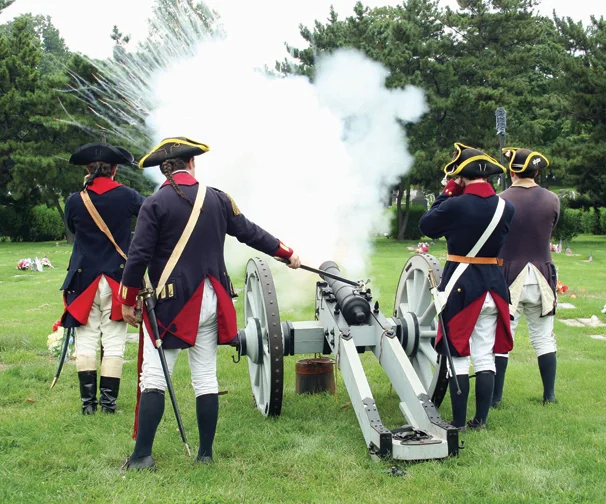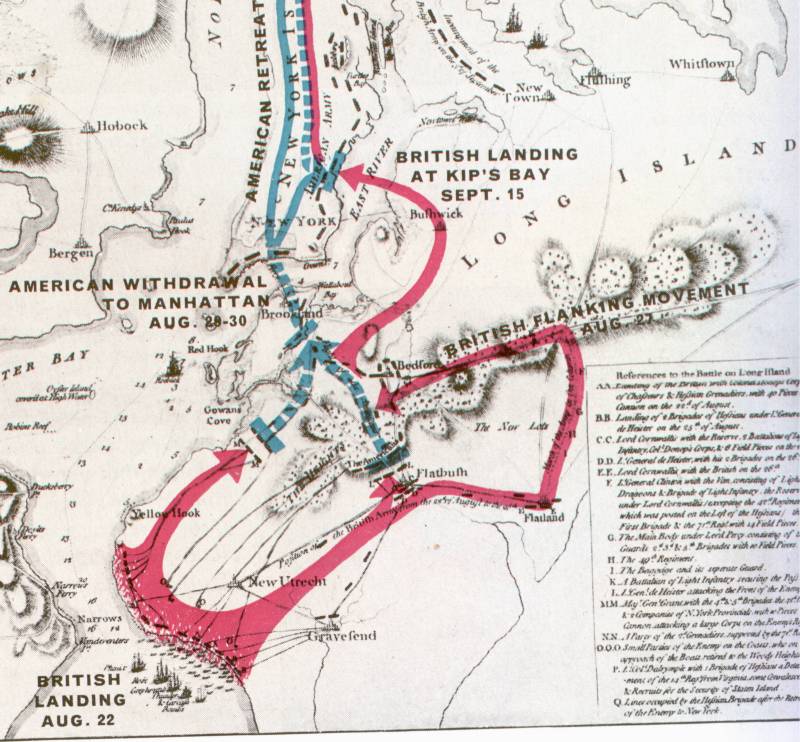The Battle of Brooklyn.
The Battle of Brooklyn was one of the most critical moments in world history. The margins of this battle would determine the very existence of the United States. In this battle, the fate of the American Patriots was determined by the narrow escape of their Commander-in-Chief, George Washington, from the British across the East River in a single night.
Brooklyn is strategically located on the western tip of Long Island, with coastline on the New York Bay which connects to the Hudson River. That means securing this location would allow the British to limit access on the Hudson River and be able to contain the western border of the Connecticut Colony.
To add, due to the British naval advantage of experience, ships and cannons, a headquarters in Brooklyn alone would likely result in containing Long Island because Long Island is simple to defend with the navy once a port is secure. And due to its proximity to the Continent, Long Island is an essential island-hop to quickly and safely transfer the British Army from Britain onto the Continent via the Hudson River or across the Long Island Sound. The British could drop off troops in Brooklyn to then push North through Manhattand, and then the Bronx and up the coast of Connecticut to Boston. By being securely garrisoned in Long Island, the British can govern the significant regions around New York Bay: Staten Island, New York (Manhattan), the Connecticut coast and the Hudson River waterfront at least.
Therefore, the Battle of Brooklyn is often referred to the Battle of Long Island, if you consider all the territory that was really at stake with the victory on Brooklyn soil. The purpose of the battle was to secure Long Island, not just Brooklyn.
Shortly after the Declaration of Independence, 4th of July, 1776, was signed, the British navy docked in the New York Bay.
On the 22nd of August, 1776, American Patriots were stationed in Kings County to defend the New York (Manhattan) considering the advantages of hills in Brooklyn, and so, the British troops landed on Staten Island to prepare an assault in the coming days [1]. British troops, then, landed on Brooklyn around Gravesend on the 26th of August, commanded by General William Howe. And on the morning of the 27th of August, they began the march north against the Patriots. Half the army marched towards Sunset Park, and fought the Patriots at Gowanus Pass near the Flatbush side of now Prospect Park [2]. The other half of the British troops went through Jamaica Pass in Queens to successfully flank the Patriots. The Patriots, in panic, retreated under the instruction of the General George Washington to Brooklyn Heights. The British slaughtered many Patriots as they ran through the Gowanus Marsh with the mud and water at knee-height [1].
Late in the day, the British decided to camp overnight, thinking that the Patriots knew they had lost and would surrender in the morning. However, in this night, George Washington inspired his Patriots to not surrender, and to accept the hardship of escaping with their lives and continue to fighting the British, after having seen the strength of the British military [2]. Under the cover of darkness and fog, the Patriots crossed the East River to New York (Manhattan) to complete the retreat [3]. They crossed one rowboat at a time, and campfires were left lit to not raise suspicions. And with their last boat, George Washington made a great escape that would send ripples through history for years to come.
The British were one march away from capturing George Washington and likely ending the rebellion. Some notes of the British troops express some soldiers were even anxious that night to continue and felt hindered in their pursuit to victory. But instead of concluding to the fight, Washington successfully brought the army to Manhattan and further up North, where the Patriots would go deeper into the woods and develop the Continental Army that would win the war that would secure the birth of a nation and a Constitution of Securing Freedoms.
By Nick Borak
Places to Visit:
Old Stone House - Park Slope, Brooklyn
A replica of the house where the historic stand occurred: outnumbered Patriots sacrificed themselves to slow the advancing British forces on Brooklyn Heights. Now, it is a cultural center that regularly hosts events and meetings.
Prospect Park - Brooklyn
A gem of a park where many troops laid fire in the Battle of Brooklyn. Inside the park, there is a plaque marking a significant battle pass.
Green-Wood Cemetery - Brooklyn
A historical and beautiful cemetery where much fighting occurred during the Battle of Brooklyn and hosts many historical graves from a variety of American wars. There is a monument on Battle Hill within the cemetery. The site hosts many events, including reenactments of the Battle of Brooklyn.
Fort Greene Park - Fort Greene, Brooklyn
A park named after General Nathanael Greene, who erected Fort Putnam which protected General Washington as he retreated. There is a tall column monument at the peak of the hill, a playground and tennis courts.
Sources
[1] Battle of Long Island. The American Revolution. PBS. 5 December 2017. Video.
https://www.youtube.com/watch?v=LdPI6T1kqD0
[2] Redcoats land at Long Island. This Day in History. History.com. 5 December 2017.
http://www.history.com/this-day-in-history/redcoats-land-at-long-island
[3] Early and Colonial Years. History of Brooklyn. Thirteen: Media With Impact. 5 December 2017.
DISCLAIMER: Most information is acquired by surfing the internet, reading books and watching documentaries. We try to give credit where credit is due. If you find an error or issue with the content, please contact us so we can try to verify and edit the information.















